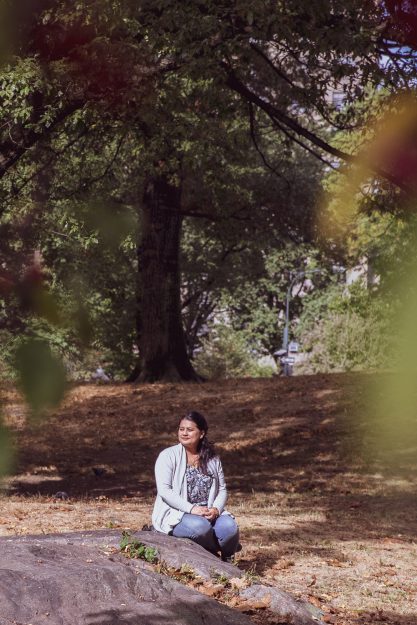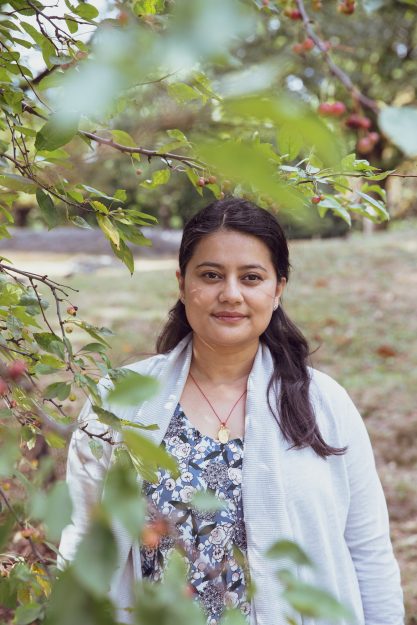From the writings of ecologist Joanna Macy to the strategies of climate action group Extinction Rebellion, environmentalism in the West has long been nurtured and informed by Buddhist perspectives.
Dekila Chungyalpa now clearly sees how the dharma that she grew up with shaped her path to becoming the director of the Loka Initiative, a climate change outreach program for faith leaders—but she wasn’t always able to reconcile her career as a conservationist with her identity as a Tibetan Buddhist.
“I had to have this moment of reckoning, because I knew I would lose credibility among peers who thought that what I was doing was too touchy-feely. People said that it would affect my reputation as a scientist and field conservationist,” she told Tricycle.
She had just started a promising career at the World Wildlife Fund (WWF) in the early 2000s, when a meeting with the Karmapa, one of most influential Tibetan lamas, changed everything.
At the time, Dekila was the youngest director at the WWF, and she and her fellow scientists were waking up to some of the alarming truths that now make up the devastating headlines and despairing reports of the contemporary news cycle. Seeking a vacation from the mental anguish, Dekila went with her family on a pilgrimage to Bodhgaya. It was there, at the site of the Buddha’s awakening, that she had an audience with Ogyen Trinley Dorje, one of the two claimants to the title of the 17th Karmapa and the head of the Karma Kagyu school of Tibetan Buddhism. He asked Dekila to create environmental guidelines for his monasteries in northern India.
It was a karmic offer she couldn’t refuse.
“I thought, OK, great—my next lifetime is secure. I’m about to add so many karma points to my karma bank,” she recalls. “I’ll draft up these guidelines and go back to my normal work.”
But the Karmapa’s vision went beyond a simple handbook about recycling for monastics. “He was clear that the monks and nuns should not remain on their brocade mats. He wanted them to go out into the community and start grappling with floods, droughts, and abnormal monsoons—the very real environmental changes that they were seeing outside their windows.”
“He was ready to start a plan of mitigation: making the carbon footprint of these Kagyu monasteries as small as possible.”
Khoryug, as the project became known, is a network of monasteries in the Himalayas working to protect the environment and institute practical measures, like installing solar panels, rooftop rainwater harvesting, and growing vegetables. Dekila still serves as the environmental advisor to the Karmapa, facilitating reforestation efforts and disaster management strategies for over 50 monasteries and nunneries.
Her involvement in Khoryug led Dekila to found WWF’s Sacred Earth in 2009, a program that expanded Khoryug’s vision beyond the Tibetan Buddhist community, building relationships with religious institutions—including churches, monasteries, and indigenous communities—toward the goal of solidifying conservation efforts around the world.
***
Although the twists of fate that led to a career transition happened naturally, it wasn’t always easy for Dekila to own her decision to bridge the gap between environmental science and personal faith.
“For most of my education and career, I was made to feel like it was unscientific to subscribe to spiritual beliefs, and that it was unprofessional to bring your religion into the workplace. Being a brown Himalayan woman, I also felt this unspoken pressure to display my culture but suppress my spiritual identity.
“When I began to work in an interfaith context, it was first and foremost a healing experience for me, because I was finally able to bring the science and my own faith together and say, ‘I am these two things wholly and completely’—that there doesn’t need to be a contradiction,” she said. “But it took some time for me to get there.”
Dekila was born in Sikkim, a state in northeastern India nestled among Tibet, Bhutan, Nepal, and Bangladesh. Around the time Dekila became a teenager, her mother left home to start a three-year solitary retreat, a practice common to serious Vajrayana practitioners, but unusual for women at the time.
“My mom was really careful to explain to me that she was doing it out of her love for me, and out of a drive to reach the level of meditative equipoise she had been practicing toward. She felt that there was no other choice, that this had to be the next step.”
Her mother, Ani Dechen Zangmo, was a Buddhist nun who chose to live by herself instead of in a nunnery. She later became the root teacher of American lama Justin von Budjoss. “She was a powerful female presence in a predominantly male dharma world,” he said, reflecting on Ani Zangmo’s willingness to shake up the status quo. “She knew that there was a politics to that, but it wasn’t born out of politics.”
Dekila grew up with her mother and the rich familial love offered by her extended family (“all of my family’s houses were clustered right next to each other; it really was a kind of ‘it takes a village’ situation”), as well as her grandmother (also a nun), who encouraged the young environmentalist’s passion for the natural world. “Probably by the time I was six or seven, my place of comfort and refuge had become the trees outside.”
While the war on climate change is sometimes framed as exactly that—a war, with either the earth or humans in the role of relentless attacker, the metaphor never resonated with Dekila. “I grew up knowing that the earth cradles me and cradles humanity. At no point have I felt that my relationship with nature is an adversarial one.”
This wholehearted trust has led Dekila down a path of lifelong ecological service.
“Working with monks and nuns helped me awaken to the truth of interdependence scientifically, spiritually, and professionally. It helped unite the pieces of my identity, and made me realize that this unity was a source of strength that could benefit others,” she explained.
***
Dekila now heads the Loka Initiative, a new project which she co-founded with Buddhist scholar-researchers Dr. Richard Davidson and Dr. John Dunne of the University of Wisconsin-Madison’s Center for Healthy Minds. Launched in 2018, the initiative hosted its first symposium last year, uniting religious leaders with environmental experts in an effort to spark new dialogue, and bolster climate activism by tapping into existing forms of community resilience that are already the bread and butter of many religious institutions.
“The thing is, I found that religion was a way to reach people. Framing the problem of climate change in terms of people’s own spiritual mission—their mandate for why they chose a religious life—helps me connect them to the reality of ecological devastation and the things we can do about it.”
The Loka Initiative has worked with a variety of faith groups, including American evangelicals, who Dekila said get a bad rap. “There’s a tendency from the science side to look at evangelicals in particular and say, ‘They’re all climate deniers.’ But I think this attitude comes from a place of deep attachment to our own identity and an unwillingness to imagine that the people we don’t agree with are motivated by the same things we are—by a desire to be happy and healthy.”
Overlooked by the media, Christian groups that organize on the ground and promote sustainability are a growing trend. “Churches have always been the first responders, and often function as a kind of coordination hub during a crisis,” Dekila observed. “In the US, churches are consistently the most generous group when it comes to giving after a disaster.
“So, while an evangelical leader may not believe in climate science, he is still part of the climate solution. He still has a role to play in helping his community prepare for the effects of climate change and minimize their carbon footprint.”
Dekila’s efforts haven’t gone unnoticed. She earned the prestigious Yale McCluskey Award for conservation innovation in 2014, has published multiple papers, and frequently speaks about her work at places like the American Museum of Natural History in New York City. She remains a fellow at WWF and sits on the board of the Society of Conservation Biology’s Religion and Conservation Working Group.
Today she reflects on the sense of wholeness she now feels.
“When I first started conceptualizing Sacred Earth, I received some advice from Martin Palmer, founder of the Alliance of Religions in the UK, who told me that as long as I could be authentic in presenting myself as a person of faith first and a scientist second, no faith leader would turn me away.
“That’s proven to be the case so far.”

